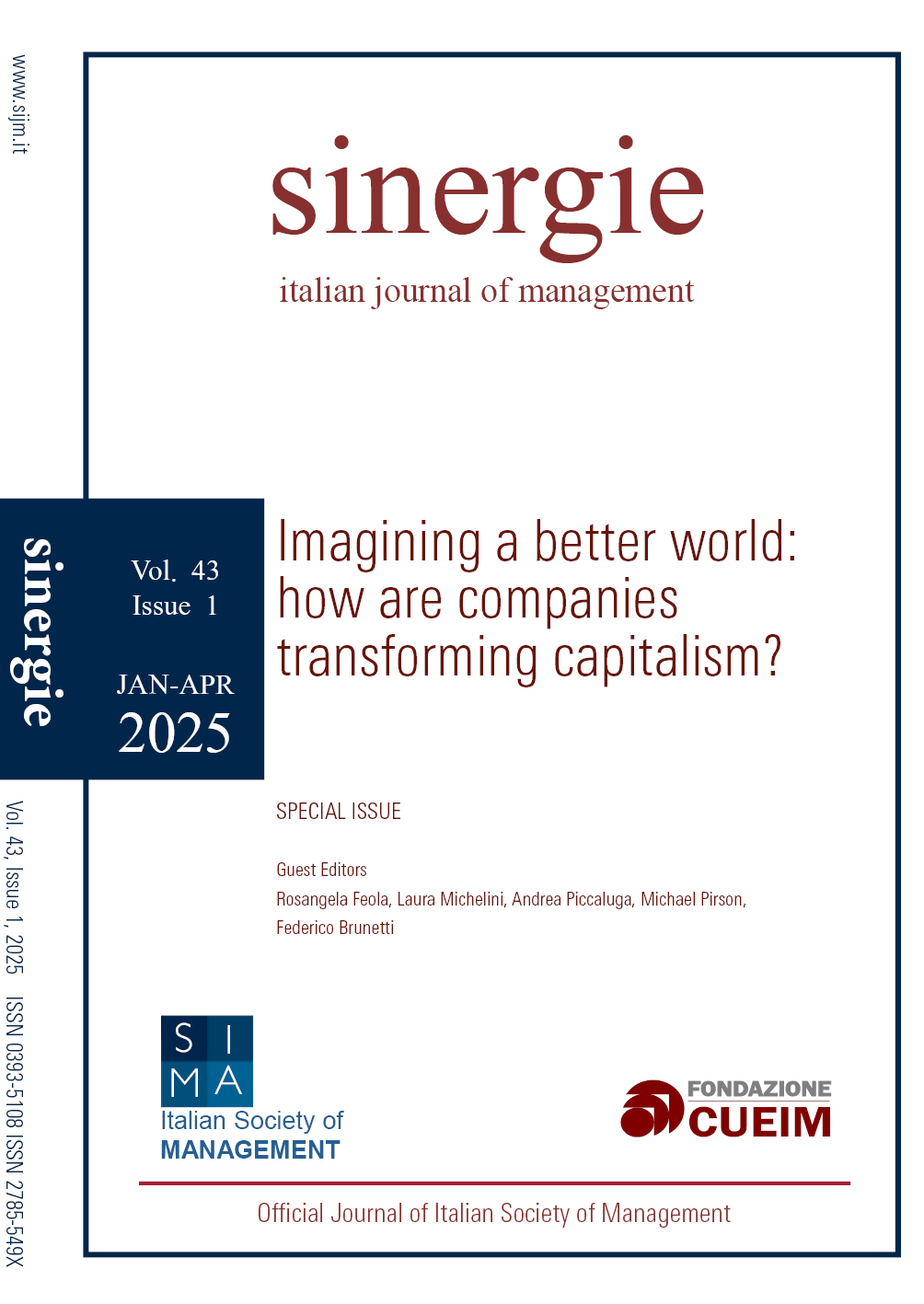Imagining a better world: how are companies transforming capitalism?
DOI:
https://doi.org/10.7433/s126.2025.01Keywords:
businessAbstract
“The factory cannot look only at the profit index. It must distribute
wealth, culture, services, democracy”. This is what Adriano Olivetti, one of
the most enlightened Italian entrepreneurs, claimed more than seventy
years ago, concretely demonstrating that a different model of value creation
was possible in the business sector, aimed not only at generating relevant
economic return for shareholders, but also at contributing to the lives of
employees, local communities, suppliers, customers, society at large.... continued
References
BACCARANI C. (1991), “Qualità e governo dell’impresa”, Quaderno n. 7 di Sinergie
BILLIS D., ROCHESTER C. (2020), “Introduction to the Handbook on Hybrid Organisations”, Handbook on Hybrid Organisations, pp. 1-29.
CARROLL A.B. (1999), “Corporate social responsibility: Evolution of a definitional construct”, Business and Society, vol. 38, n. 3, pp. 268-295.
COVIN J.G., LUMPKIN G.T. (2011), “Entrepreneurial orientation theory and research: Reflections on a needed construct”, Entrepreneurship Theory and Practice, vol. 35, n. 5, pp. 855-872.
COVIN J.G., SLEVIN D.P. (1989), “Strategic management of small firms in hostile and benign environments”, Strategic Management Journal, vol. 10, n. 1, pp. 75-87.
COVIN J., SLEVIN D.P. (1991), “A Conceptual Model of Entrepreneurship as Firm Behavior”, Entrepreneurship Theory and Practice, vol. 16, n. 1, pp. 7-25.
DOHERTY B., HAUGH H., LYON F. (2014), “Social enterprises as hybrid organizations: A review and research agenda”, International Journal of Management Reviews, vol. 16, n. 4, pp. 417-436.
FITZGERALD M. (2019, August 19), The CEOs of nearly 200 companies just said shareholder value is no longer their main objective. Retrieved from https://www.cnbc.com/2019/08/19/ the-ceos-of-nearly-two-hundred-companies-say-shareholder-value-is-no-longer-theirmain-objective.html
FREEMAN R.E. (1984), Strategic management: A stakeholder approach, Cambridge University Press., Cambridge, MA.
HAIGH N., WALKER J., BACQ S., KICKUL J. (2015), “Hybrid organizations: Origins, strategies, impacts, and implications”, California Management Review, vol. 57, n. 3, pp. 5-12.
KRAMER M.R., PORTER M.E. (2006), “Strategy and society: The link between competitive advantage and corporate social responsibility”, Harvard Business Review, vol. 84, n. 12, pp. 78-92.
KRAMER M.R., PORTER M.E. (2011), Creating shared value, FSG Boston, MA, USA.
MAYER C. (2016), “Reinventing the corporation”, Journal of the British Academy, vol. 4, pp. 53-72.
MAYER C. (2021), “The Future of the Corporation and the Economics of Purpose”, Journal of Management Studies, vol. 58, n. 3, pp. 887-901.
PARENTE R., KIM K.C. (2021), “Contemporary perspectives on social and humane entrepreneurship”, Journal of Small Business Management, vol. 59, n. 3, pp. 371-372.
PARENTE R., EL TARABISHY A., BOTTI A., VESCI M., FEOLA R. (2021), “Humane entrepreneurship: Some steps in the development of a measurement scale”, Journal of Small Business Management, vol. 59, n. 3, pp. 509-533.
PARENTE R., EL TARABISHY A., VESCI M., BOTTI A. (2018), “The Epistemology of Humane Entrepreneurship: Theory and Proposal for Future Research Agenda”, Journal of Small Business Management, vol. 56, n. S1, pp. 30-52.
PIRSON M. (2017), Humanistic management: Protecting dignity and promoting well-being, Cambridge University Press., Cambridge, MA.
THE BRITISH ACADEMY (2018), “Reforming Business for the 21st Century”.
VESCI M., BOTTI A., FEOLA R., CONTI E., EL TARABISHY A (2023), “Bridging Theory and Practice in Humane Entrepreneurship: Insights from Italian Small and Medium Enterprises”, Journal of Small Business and Enterprise Development, vol. 30, n. 3, pp. 567-586.
YUNUS M., MOINGEON B., LEHMANN-ORTEGA L. (2010), “Building social business models: Lessons from the Grameen experience”, Long Range Planning, vol. 43, n. 2-3, pp. 308-325.


